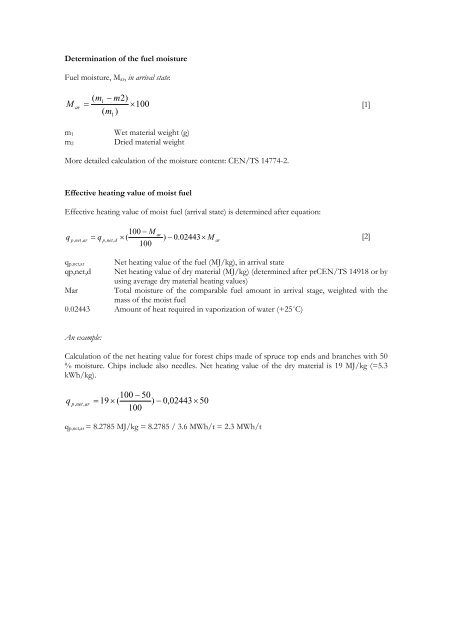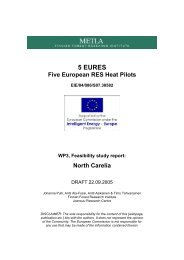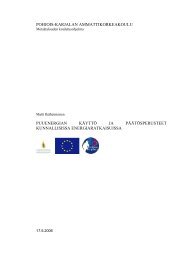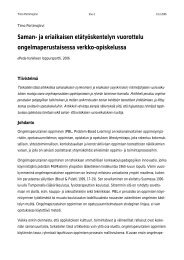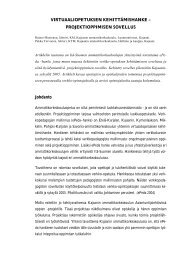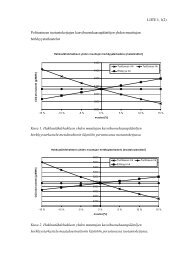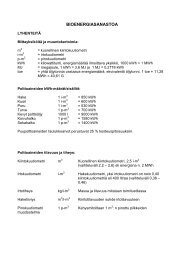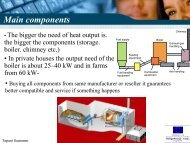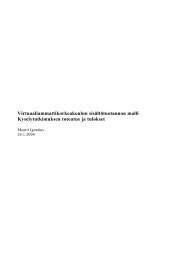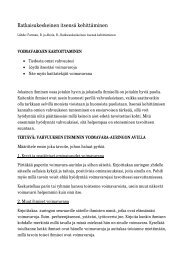Calculation principles
Calculation principles
Calculation principles
Create successful ePaper yourself
Turn your PDF publications into a flip-book with our unique Google optimized e-Paper software.
Determination of the fuel moisture<br />
Fuel moisture, Mar, in arrival state:<br />
( m1<br />
− m2)<br />
M ar = × 100<br />
[1]<br />
( m )<br />
1<br />
m1 Wet material weight (g)<br />
m2 Dried material weight<br />
More detailed calculation of the moisture content: CEN/TS 14774-2.<br />
Effective heating value of moist fuel<br />
Effective heating value of moist fuel (arrival state) is determined after equation:<br />
100 − M<br />
q ×<br />
100<br />
ar<br />
p net ar = q p net d × ( ) − 0.<br />
02443 M<br />
[2]<br />
, , , ,<br />
ar<br />
qp,net,ar Net heating value of the fuel (MJ/kg), in arrival state<br />
qp,net,d Net heating value of dry material (MJ/kg) (determined after prCEN/TS 14918 or by<br />
using average dry material heating values)<br />
Mar Total moisture of the comparable fuel amount in arrival stage, weighted with the<br />
mass of the moist fuel<br />
0.02443 Amount of heat required in vaporization of water (+25˚C)<br />
An example:<br />
<strong>Calculation</strong> of the net heating value for forest chips made of spruce top ends and branches with 50<br />
% moisture. Chips include also needles. Net heating value of the dry material is 19 MJ/kg (=5.3<br />
kWh/kg).<br />
q p,<br />
net,<br />
ar<br />
100 − 50<br />
= 19 × ( ) −<br />
100<br />
0,<br />
02443×<br />
50<br />
qp,net,ar = 8.2785 MJ/kg = 8.2785 / 3.6 MWh/t = 2.3 MWh/t
<strong>Calculation</strong> of the energy density<br />
When fuel trade is made in volumetric units, energy density is calculated by using fuel net heating<br />
value and bulk density.<br />
1<br />
E ar = × q p,<br />
net,<br />
ar × BD<br />
3600<br />
Ear Energy density of the fuel (MWh/loose m3)<br />
qp,net,ar Net heating value of the moist fuel (MJ/kg)<br />
BDar Bulk density (kg/loose m3)<br />
1/3600 Transfer coefficient (MJ to MWh)<br />
ar<br />
Result is usually reported with two decimals (MWh/loose m 3)<br />
An example:<br />
1<br />
E ar = × 8.<br />
2785 × 350<br />
(MWh/loose m<br />
3600<br />
3)<br />
Ear = 0.80 MWh/loose m 3<br />
Transfer coefficients:<br />
toe MWh GJ Gcal<br />
toe 1 11.63 40.868 10.0<br />
MWh 0.0886 1 3.600 0.86<br />
GJ 0.02388 0.2778 1 0.2388<br />
Gcal 0.1 1.163 4.1868 1<br />
An example:<br />
1 toe = 11.63 MWh<br />
1 kWh = 3.6 MJ<br />
References:<br />
Alakangas, E. 2000. Suomessa käytettyjen polttoaineiden ominaisuuksia, Valtion teknillinen<br />
tutkimuskeskus, VTT Tiedotteita 2045. Espoo.<br />
Kokkonen, A & I. Lappalainen (eds.) 2005. Hakelämmöstä yritystoimintaa. Pohjois-Karjalan<br />
ammattikorkeakoulu, Motiva Oy ja Työtehoseura. Kuopio 2005.<br />
[3]


